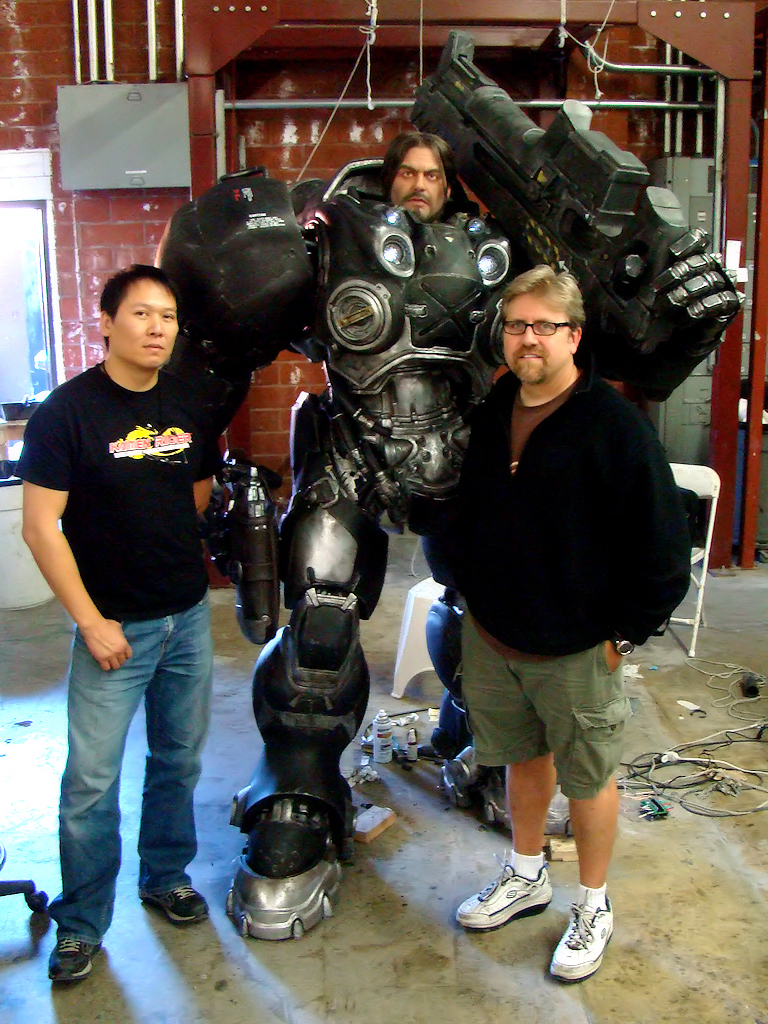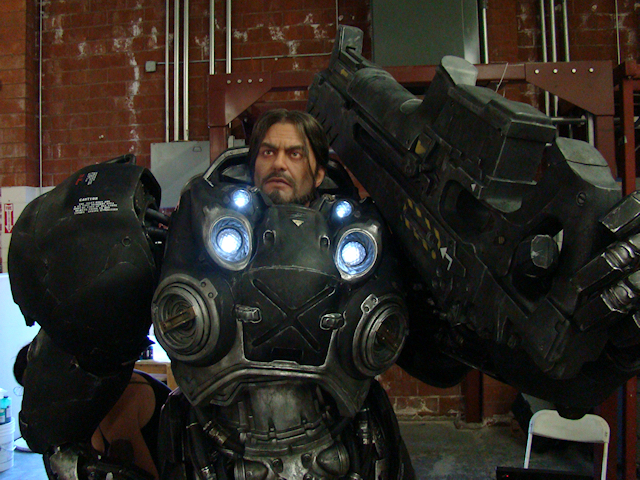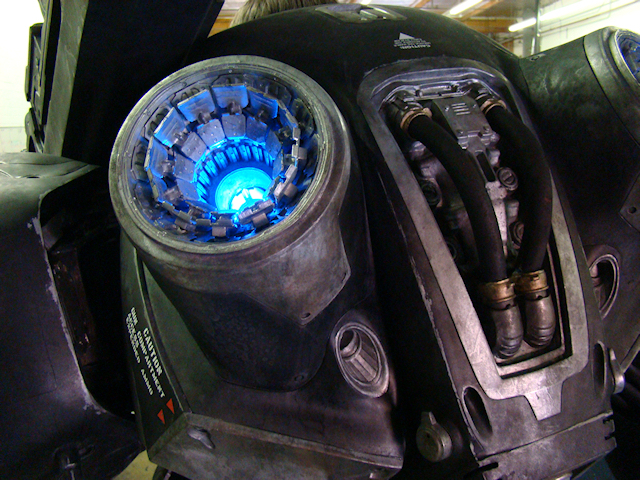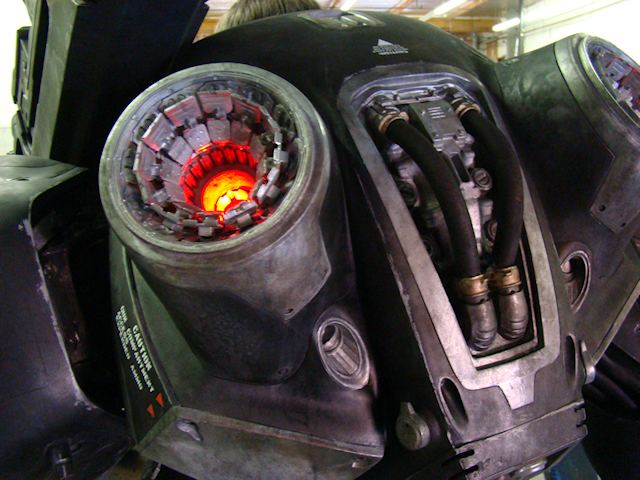Propeller-Powered Starcraft II Marine
 JonnyMac
Posts: 9,556
JonnyMac
Posts: 9,556
I have the good fortune to know -- and get to help from time-to-time -- Hollywood FX legend, Steve Wang. I bumped into him at IMATS a couple months ago and he asked if I could create a multi-channel lighting controller for a new project.
That project turned out to be a life-sized Starcraft II marine that is on display at BlizzCon this weekend. I created a 12-channel LED driver for the Propeller Platform and most of the code is in Spin (other than the BAM driver for LED modulation).
There is one channel that "assists" the video flicker on the face. There are four channels on the chest plate; they fade up and "stutter" in unison (like an old, fluorescent lamp) but each has a random dither value to give them their own life; once full light they shimmer (again, each with an independent dither value). Finally, there are two, high-brightness RGB LED modules on the back for engine exhaust ports.
Not a difficult project, but was very fun. Steve and his crew loved the lighting and he told me his client was thrilled with it.
That project turned out to be a life-sized Starcraft II marine that is on display at BlizzCon this weekend. I created a 12-channel LED driver for the Propeller Platform and most of the code is in Spin (other than the BAM driver for LED modulation).
There is one channel that "assists" the video flicker on the face. There are four channels on the chest plate; they fade up and "stutter" in unison (like an old, fluorescent lamp) but each has a random dither value to give them their own life; once full light they shimmer (again, each with an independent dither value). Finally, there are two, high-brightness RGB LED modules on the back for engine exhaust ports.
Not a difficult project, but was very fun. Steve and his crew loved the lighting and he told me his client was thrilled with it.






Comments
I just got to make a bunch of lighting effects for a local show that is trying to get a spot on Adult Swim on Cartoon Network. I used Basic Stamps. haha
Maybe one day I can grow up to be like you!
Any video of the lighting when active?
I was expecting to see a robot-guided boat (I guess "Propeller-powered" primed me for that).
Googling sends me to some pages that suggest it's from a computer game...?
Information here: http://us.blizzard.com/en-us/games/sc2/
http://www.nytimes.com/2010/08/10/science/10gamers.html
@JonnyMac
I've had similar experiences with Propeller, on many occasions it has got me out of a pickle or helped me win a contract (or two).
The point is, Propeller helps to make things easy and quick, yeah there are people out there who can push the envelope with it, that just proves how versatile it is.
And how cool is that model anyway, who cares if you don't know what it is, it's a piece of art!!!
Thanks for sharing.
Coley
What I like is the ability to be flexible which in most businesses, including (perhaps especially in) "Hollywood," is a desirable trait.
While testing the board I decided to add the ability to isolate a section (there are three: face, chest, engines) using a TV remote control. With the Propeller it was a no-brainer, and took about 10 minutes to fully integrate (I had an RC-5 receiver in my "toolbox"). In the end, we don't really use it (the program cycles the various areas on-and-off) but Steve loved that I could add in remote control and do it painlessly and I'm sure he'll have me use this in another project.
Yes, it really is a simple lighting controller, but it is simple because the Propeller architecture and programming languages make it so.
And I've seen it up close and it is amazing. Keep in mind that most of Steve's work gets projected on big screens. He's created some really cool costumes/creatures for movies like Predator, Underworld, Van Helsing, Hellboy, and many many others. And there a funny thing about Hollywood "monster" makers: they tend to be really nice people. Steve is one of the nicest.
I've just read the N&V article on JM's 12 channel light driver. Nice work! Love it!
I kind of wish I had seen that trailer before the project. All of my programming was based from verbal descriptions by Steve. When I did find the trailer -- after my work was done -- I contacted him to see if he wanted me to match it. He told me that he and the client loved it as is so there was no need.
In a way, part of it was. Due to a very compressed schedule they used models from the game company and "3D printing" to make rough parts of major sections. They "body shopped" (i.e., used bondo and sandpaper to repair/improve) those and then built molds from which fiberglass parts were cast. A big exception is the head: Steve had to sculpt that from scratch going from the images (no actor to life cast for this one). The head has realistic glass eyes and punched hair -- just like a traditional movie prop.
For me, though, the real magic is in the painting and detailing -- it's amazing, even up close.
One of Steve's crew, Johnny, shook my hand and said that the lighting "brought it to life." That was a very kind thing to say; I was just happy to be part of such a cool project and be (a very small) part of a team of really gifted artists.
Great article and thanks for the info. on the Renard protocol. I had never heard of it and it looks like it may work well for a project I have in mind.
One thing I was wonder about regarding the Propeller Platform, are there any size requirements for a Propeller Platform board? I guess I'm wondering if there would be any rules agains designing a Propeller Platofrom module that overhung the Propeller Platform itself? Of course, please understnad I don't know much about board desing either. Just thinking out of the box here.
When I created the original Propeller Platform I use the standard ExpressPCB "mini board" size just to keep things easy. Nick has created a shorter version so some of the original platform modules do overhang. There are no rules save to have fun and do cool stuff!